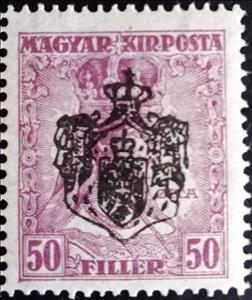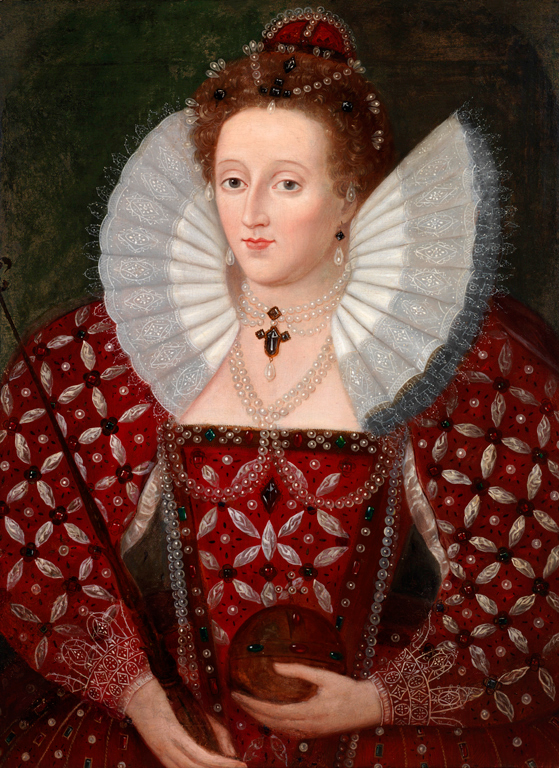Stamp: King Charles IV and Queen Zita - overprinted (Hungary, Serbian Occupation of Banat and Bacska 1919)
King Charles IV and Queen Zita - overprinted (Hungary, Serbian Occupation of Banat and Bacska 1919)
15 February (Hungary, Serbian Occupation of Banat and Bacska ) within release Ada issue goes into circulation Stamp King Charles IV and Queen Zita - overprinted face value 50 Hungarian fillér
| Stamp King Charles IV and Queen Zita - overprinted in catalogues | |
|---|---|
| Philatelia Hungarica Catalog: | PHu: HU-ADA 17 |
Stamp is vertical format.
The serb troops occupied Bánát-Bácska county, and this serie was issued in ADA city by Military authorization. The stamps got the overprint of Yugoslavian Royal Coat of Arms. Black overprint on Mi: HU 218 Ada Overprint - small crown on top of shield has only 1 line in middle.Also in the issue Ada issue:
- Stamp - King Charles IV and Queen Zita - overprinted face value 10;
- Stamp - King Charles IV and Queen Zita - overprinted face value 20;
- Stamp - King Charles IV and Queen Zita - overprinted face value 40;
- Stamp - King Charles IV and Queen Zita - overprinted face value 50;
- Stamp - Newspaper stamp - overprinted face value 2;
- Stamp - Parliament building - overprinted face value 75;
- Stamp - Parliament building - overprinted face value 80;
- Stamp - Parliament building - overprinted face value 1;
- Stamp - Postage Due - overprinted face value 1;
- Stamp - Postage Due - overprinted face value 2;
- Stamp - Reaper (coloured numbers) - overprinted face value 2;
- Stamp - Reaper (coloured numbers) - overprinted face value 3;
- Stamp - Reaper (coloured numbers) - overprinted face value 5;
- Stamp - Reaper (coloured numbers) - overprinted face value 6;
- Stamp - Reaper (coloured numbers) - overprinted face value 15;
- Stamp - Reaper (coloured numbers) - overprinted face value 25;
- Stamp - Reaper (coloured numbers) - overprinted face value 35;
- Stamp - Reaper (coloured numbers) - overprinted face value 40;
- Stamp - Special Delivery Stamp - overprinted face value 2;
Stamp King Charles IV and Queen Zita - overprinted it reflects the thematic directions:
In British heraldry, a coronet is any crown whose bearer is less than sovereign or royal in rank, irrespective of the crown's appearance. In other languages, this distinction is not made, and usually the same word for crown is used irrespective of rank (German: Krone, Dutch: Kroon, Swedish: Krona, French: Couronne, etc.) In this use, the English coronet is a purely technical term for all heraldic images of crowns not used by a sovereign, and implies nothing about the actual shape of the crown depicted. A Coronet is another type of crown, but is reserved for the lower ranks of nobility like Marquesses and Marchionesses, Earls and Countesses, Barons and Baronesses, and some Lords and Ladies. The specific design and attributes of the crown or coronet signifies the hierarchy and ranking of its owner.
A head of state (or chief of state) is the public persona that officially represents the national unity and legitimacy of a sovereign state. In some countries, the head of state is a ceremonial figurehead with limited or no executive power, while in others, the head of state is also the head of government. In countries with parliamentary governments, the head of state is typically a ceremonial figurehead that does not actually guide day-to-day government activities and may not be empowered to exercise any kind of secular political authority (e.g., Queen Elizabeth II as Head of the Commonwealth). In countries where the head of state is also the head of government, the president serves as both a public figurehead and the actual highest ranking political leader who oversees the executive branch (e.g., the President of the United States).
Queen - the title of reigning female monarch or the wife of the king in a number of countries
A Royalty is the immediate family of a king or queen regnant, and sometimes his or her extended family. The term imperial family appropriately describes the family of an emperor or empress, and the term papal family describes the family of a pope, while the terms baronial family, comital family, ducal family, grand ducal family, or princely family are more appropriate to describe the relatives of a reigning baron, count, duke, grand duke, or prince. However, in common parlance members of any family which reigns by hereditary right are often referred to as royalty or "royals." It is also customary in some circles to refer to the extended relations of a deposed monarch and his or her descendants as a royal family. A dynasty is sometimes referred to as "the House of ...". As of July 2013, there are 26 active sovereign monarchies in the world who rule or reign over 43 countries in all




